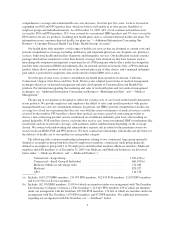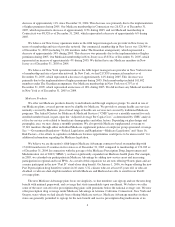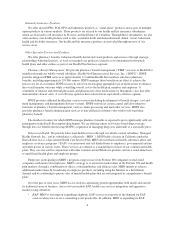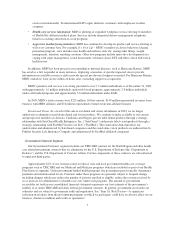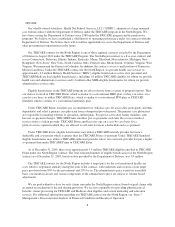Health Net 2005 Annual Report Download - page 12
Download and view the complete annual report
Please find page 12 of the 2005 Health Net annual report below. You can navigate through the pages in the report by either clicking on the pages listed below, or by using the keyword search tool below to find specific information within the annual report.member utilization of professional services. The capitation fee represents payment in full for all medical and
ancillary services specified in the provider agreements. In these capitation fee arrangements, in cases where the
capitated PPG cannot provide the health care services needed, such PPGs generally contract with specialists and
other ancillary service providers to furnish the requisite services under capitation agreements or negotiated fee
schedules with specialists. Outside of California, most of our HMOs reimburse physicians according to a
discounted fee-for-service schedule, although several have capitation arrangements with certain providers and
provider groups in their market areas.
Our Connecticut HMO has a contract with the Connecticut State Medical Society IPA (“CSMS”). In 2005,
we converted our contract with CSMS from a capitated risk arrangement coupled with a reinsurance agreement
between CSMS and Health Net Services (Bermuda), Ltd., a wholly-owned subsidiary of the Company, to a
fee-for-service arrangement with gain-share and pay-for-performance features. As a result, we eliminated the
reinsurance arrangement and all administration, referral authorization and claims administration is now
performed by our Connecticut health plan and physicians are paid on a fee-for-service basis.
The inability of provider groups to properly manage costs under capitation arrangements can result in their
financial instability and the termination of their relationship with us. A provider group’s financial instability or
failure to pay secondary providers for services rendered could lead secondary providers to demand payment from
us, even though we have made our regular capitated payments to the provider group. Depending on state law, we
could be liable for such claims.
For services provided under our PPO products and the out-of-network benefits of our POS products, we
ordinarily reimburse physicians pursuant to discounted fee-for-service arrangements.
Hospital Relationships
Our health plan subsidiaries arrange for hospital care primarily through contracts with selected hospitals in
their service areas. These hospital contracts generally have multi-year terms or annual terms with automatic
renewals and provide for payments on a variety of bases, including capitation, per diem rates, case rates and
discounted fee-for-service schedules.
Covered inpatient hospital care for our HMO members is comprehensive. It includes the services of
hospital-based physicians, nurses and other hospital personnel, room and board, intensive care, laboratory and
x-ray services, diagnostic imaging and generally all other services normally provided by acute-care hospitals.
HMO or PPG nurses and medical directors are actively involved in discharge planning and case management,
which often involves the coordination of community support services, including visiting nurses, physical therapy,
durable medical equipment and home intravenous therapy.
In late 2001, we began to see a pronounced increase in the number of high dollar, stop-loss inpatient claims
we were receiving from hospitals. As stop-loss claims rose, the percentage of payments made to hospitals for
stop-loss claims grew as well, in some cases in excess of 50%. This increase was caused by some hospitals
aggressively raising chargemasters and billing for items separately when we believed they should have been
included in the base charge. Management at our California health plan at that time responded to this trend by
instituting a number of practices designed to reduce the cost of these claims, including, but not limited to, line
item review of itemized billing statements and review of, and adjustment to, the level of prices charged on stop-
loss claims.
By early 2004 we began to see evidence that our claims review practices were causing significant friction
with hospitals although, at that time, there was a relatively limited number of outstanding arbitration and
litigation proceedings. We responded by attempting to negotiate changes to the terms of our hospital contracts, in
many cases to incorporate fixed reimbursement payment methodologies intended to reduce our exposure to the
stop-loss claims. As we reached the third quarter of 2004, an increase in arbitration requests and other litigation
prompted us to review our approach to our claims review process for stop-loss claims and our strategy relating to
provider disputes. Given that our provider network is a key strategic asset, and following a thorough review of all
10




